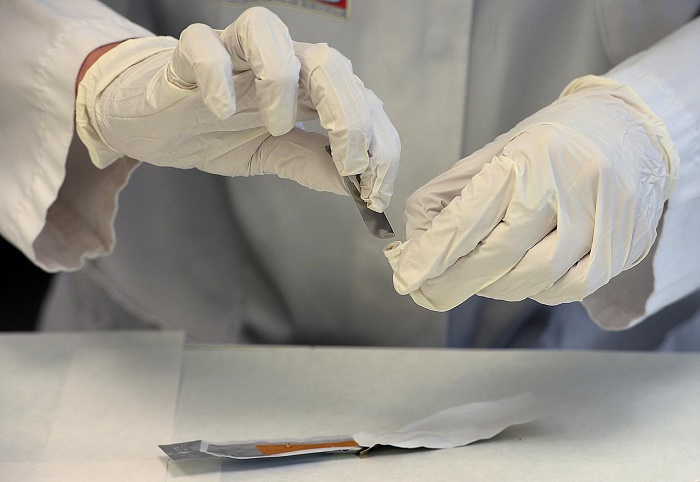While re-examining the case, investigators found Leiterman’s DNA on her pantyhose and discovered DNA belonging to another man, John Ruelas, in a sample of blood from Mixer’s hand. It could have been impossible to sort out which of the two was responsible for her murder. In this case, however, police got lucky: Ruelas was only 4 years old in 1969 and therefore couldn’t have killed Mixer. Leiterman, on the other hand, was convicted of first-degree murder.
All three samples (Mixer’s, Leiterman’s and Ruelas’s) had apparently become contaminated in the lab, which unfortunately occurs from time to time when procedures aren’t properly followed. DNA can also get contaminated at the crime scene. But that isn’t the only problem with using DNA to solve crimes. DNA also can degrade quickly if exposed to strong sunlight or moist conditions. Or there might not be enough DNA to collect.
A way around this, which has become popular in recent years, is to use “touch DNA” – genetic material transferred from an individual, through brief contact with a doorknob, say, or countertop. However, this involves only a small number of skin cells, which can easily become contaminated through secondary transfer. That is, two men shake hands, and when one of them then touches a doorknob, he leaves behind DNA from both of them.

Questions have been raised over the conviction of Gary Leiterman
The lesson: It’s often difficult to get a clean, usable sample of DNA. When there are problems with DNA collection and analysis, the consequences can be severe. Mistakes can, and have, led to wrongful convictions. Leiterman’s attorney argued, on a hunch, that the defendant’s DNA was contaminated with Mixer’s while it was being processed by the lab. Leiterman was facing a charge of falsifying prescriptions.
“DNA is still the gold standard,” says Bradley Hart, who leads the Forensic Science Centre at Lawrence Livermore National Laboratory. “But contrary to what you see on TV, nothing is perfect.” That’s why Hart and his team began their work with hair analysis. They believe this new identification method will complement DNA testing within a decade. Early results are promising, according to a report of their work published on 7 September in the journal PLOS ONE.
“The protein content of hair is variable due to people’s genetic makeup,” explains Hart. There are more than 300 different proteins in hair, although the precise combination differs for each individual. By looking at these proteins, researchers can establish an individual’s protein profile. And another advantage of hair analysis: proteins, in hair and elsewhere, are a lot stabler than DNA and can last for a longer time.
The authors report that the new method is not yet reliable enough for routine identifications. However, its accuracy is improving, and it should be able to serve as a check on possible DNA errors. To prove the method works, the team analysed hair samples from 76 men and women, mostly of European-American descent. They were able to identify 185 unique protein markers – the overall patterns of which were unique to each individual.

Denton Cemetery where Jane Mixer`s body was found (Creative Commons)
“It’s quite an exciting development in terms of what we can currently do with hair samples,” says Laura Walton-Williams, who teaches forensics at Staffordshire University in England. Hair, while still routinely collected at crime scenes, isn’t really used as forensic evidence anymore – especially after the FBI acknowledged the hair analysis its experts did from 1980 to 2000 was flawed in more than 95 percent of cases.
Experts used to analyse hair collected at a crime scene under the microscope for similarities with that obtained from a suspect. But visually comparing two strands for colour, texture, etc, was so subjective that the accuracy was often overstated. Yet hair can be incredibly useful. “Hair is always left behind, so it’s an abundant source of material for identifying people,” says Daniel Fairbanks, a hair expert at Utah Valley University and also one of the paper’s co-authors.
Additional validation needs to be done before the new method makes its way into working forensic labs and courtrooms. Researchers need to test with more people and include more ethnic groups in the study population. The amount of hair required (currently a thimbleful) needs to be reduced to a single strand. And rigorous testing of the chosen protein markers needs to be done to make sure they’re reliable.
Researchers also need to determine how the new technology can be integrated with existing technology and begin to build a database of protein profiles similar to the FBI’s Combined DNA Index System for it to be really useful. They’ll also need to find out more about how proteins in hair changes with age, diet and the environment. If the new method does prove itself, co-author Hart says, it “will be a game changer for forensics.”
Proteins in other body tissues can be examined too. Bone, teeth, muscle, nails and skin cells are all alternatives forensic scientists turn to when samples like blood, which are easier to extract DNA from, aren’t available. “It may come in very helpful in mass disasters,” says Tim Kupferschmid, head of New York City’s Office of Chief Medical Examiner, whose lab is testing a protein-identification method using muscle and bone. And its potential applications stretch beyond crime-solving: it could one day be used in wildlife forensics, as a means of distinguishing between species in poaching, hunting and other cases. As Glendon Parker, Hart’s colleague who invented the method, puts it: “It’s another tool in the toolbox.”
















































